Part 1 of the History of the Birth
and Death of the Homestead Inn in Sugar Hill, New Hampshire
Bob Jensen
at Trinity University
Set 1 of My Tribute to
Barbara Serafini
Barbara succumbed to cancer on August 27, 2018
Barbara's grandparents on the Elm Farm were among the earliest pioneers of Sugar
Hill
Part 1 of the History of the Homestead Inn Torn Down in 2015
Part 1 of
the Homestead Inn History (featuring the exterior)
Scroll Down
Part 2 of the Homestead
Inn History (featuring the interior) ---
http://www.trinity.edu/rjensen/Tidbits/Hotels/Homestead/Set02/Set02.htm
Part 1 of the
Homestead Inn History (featuring the exterior and farm buildings)
Village of Sugar Hill, New
Hampshire ---
https://en.wikipedia.org/wiki/Sugar_Hill,_New_Hampshire
Jensen Comment
The first permanent resident of
Sugar Hill in New Hampshire's
White Mountains allegedly is pioneer Moses Aldrich who in 1784 allegedly arrived on
horseback and built a crude log cabin in a forest. His father, William, had
passed through this forest in 1780 shortly after the American Revolution, but it
was his son Moses who cleared an acre of virgin timber and planted wheat which
gave him a homestead claim to the land under rights known as "pitch" land
ownership. In truth the dates are uncertain and conflict with an old gravestone
date that has William Aldrich being born in 1770. It may have been years later
when all this took place or William's date of birth may be incorrect on the
gravestone.
An exhausted and discouraged Moses
Aldrich later left to rejoin his wife Sarah in Richmond, NH. It was Sarah who persuaded Moses to return to his
pitched acre of land and cabin with her in a
wagon of belongings pulled by an ox and a cow. They later made a land deal with
a Henry Hoskins who had a land grant from the British King's Governor. Benning
Wentworth. Part of the land deal was Hoskins' acceptance of a homespun wedding
coat plus some notes. And thus it came to be that Moses and Sarah Aldrich became
owners of what later would be called the Elm Farm that had to be cleared of
timber for farming land. In 1802 they built a farmhouse and later a primitive
barn. Sarah is credited with discovering what was later called the Gibbs Spring that provided the first water before a pipe was built up to Ore Hill
for water. Sarah's
only daughter had died but on the Elm farm her niece Jerusha came to live on the
farm.
It's not at all clear how Moses and
Sarah made a living growing wheat in the rocky and short-seasoned Elm Farm not
suited for wheat. It probably was a sparse back-breaking living supplemented with timber
sales.
How would you like to raise wheat
on the land pictured below?
Besides the rocks and root-entangled soil were the hardships of three months of
a cool wind-blown summer and nine months of a frigid winter.
Relative to the buffalo-grass plains of the USA's Midwest the forested hills of New
England do not have great soil.
Forest soil is never a s good as prairie soil for growing grain.

What is also not entirely clear to
me is how and when Simon Bowles and his wife Marcia Grove (Grammy) Bowles
acquired the rocky Elm Farm in the 1800s.
I especially thank my very good
friend and neighbor Barbara Serafini for providing the material for this History
of the Homestead Inn. Barbara is the owner of the Sugar Hill Sampler gift shop
and museum. She and her three adult children still own much, but not all, of the
historic and extensive Elm Farm land along Highway 117 on the outskirts of Sugar
Hill, New Hampshire. Barbara's grandparents Simon and and his wife Marsha Grove
Bowles acquired the Elm Farm sometime in the 1800s.
Being strapped for cash on the farm
Simon and Marcia Bowles commenced to take in "boarders" into their farmhouse in
1881. Years later in 1889 Simon, who had studied engineering at Dartmouth College, commenced
a major expansion of the farm house that henceforth became the Homestead Inn at
the corner of what is now Highway 117 and Sunset Hill Road. Barbara's
grandparents both farmed and operated the Homestead Inn until the start of World
War II. I think they eventually grew more hay than wheat.
This is Simon Bowles and a friend stacking hay on a wagon

Simon and his wife had a daughter
named Esther (Essie) who married an Italian immigrant called ...Fiorenzo (Enzo, Serry) Serafini. They are the
parents of my friend Barbara Serafini. About 1940 Barbara's parents took over
the operation of the Homestead Inn --- which is why Barbara grew up with the
Homestead Inn as her shelter. Eventually she inherited both the Homestead Inn
and surrounding Elm Farm land. Later on in life she divided up some of the
property, including the Homestead Inn, with her three children but retained much
of the land and the big barn now known as the Sugar Hill Sampler gift shop and
museum.
The nearby Village of Sugar Hill
was named after its many large sugar maple trees. Today there's population of
slightly less 600 residents spread over a wooded area of 17 square miles. After
a fire that burned down much of Sugar Hill's main street Sugar Hill's "downtown" only one remaining store called Harmon's Cheese and Country Store ---
http://harmanscheese.com/
There are no remaining schools in Sugar Hill, but there is one church plus a summer chapel
(St Matthews).
Here's a picture of Erika and Bob
taken a few years back in front of our church with our San Antonio house guest
Dick Wolff (the very tall guy)
Dick retired after many years as an Air Force physician. His wife Sybil snapped
this picture.
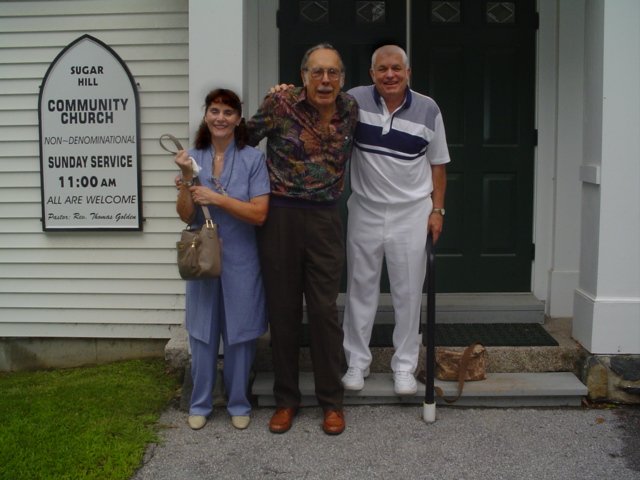
The St. Mathews Chapel is less
than a mile away from our cottage and was very close to the Homestead Inn.
We sometimes attend the summer services in this chapel.


Years ago this was the sugar
maple-lined boardwalk leading from the Homestead Inn to the St. Matthews Chapel

A ridge on the outskirts of Sugar
Hill has a dead end road called Sunset Hill Road that arguably has the most
spectacular mountain views relative to all other roads in New Hampshire (at
least that's what Sugar Hill's tax appraiser keeps telling us). Our cottage looks out at three mountain
ranges of the White Mountains, including the Kinsman Range (10 miles away), the
Twin Range (20 miles away), and the Presidential Range (30 miles away). You can
see hundreds of my mountain pictures by scrolling down to "Mountains" at
http://www.trinity.edu/rjensen/pictures.htm
Views from Our Living Room on
Sunset Hill Road (some photographs with the camera zoomed)



Mt. Washington in the
Presidential Range as seen from my desk


Franconia Notch covered in clouds
between Lafayette and Cannon
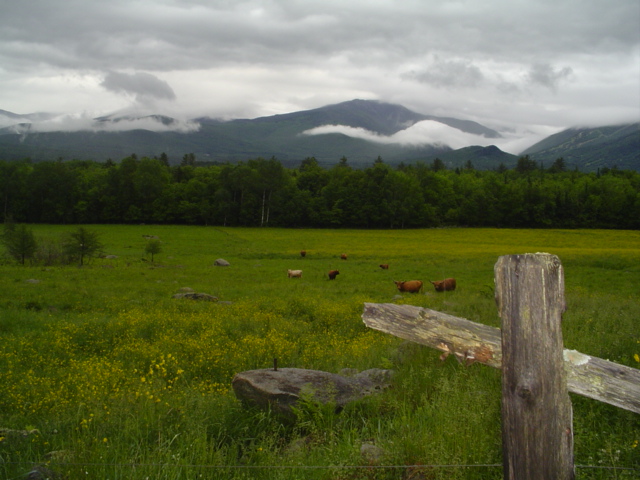
In the late 1800s until after WW II
there were three prospering hotels on Sunset Hill Road that were later taken down. The largest of these was
part of the Sunset Hill House (SHH) Resort with a large summer hotel that
accommodated over 300 guests and was intentionally demolished in 1974 when the
resort's big hotel, a casino, a bowling alley, barns, and most of the other buildings were taken
down ---
http://www.trinity.edu/rjensen/tidbits/CottageHistory/Hotel/Brochure/Brochure1900.htm
Neither the Homestead Inn to the
northeast nor the Lookoff Hotel to the southwest are visible in the old SHH
Resort postcard
below

Our cottage sits where the SHH hotel's dining room was once located
and is bounded on two sides by the resort's still-functioning golf course. The
resort's old power house serves as my barn
You can read about the history of our cottage at
http://www.trinity.edu/rjensen/pictures.htm .
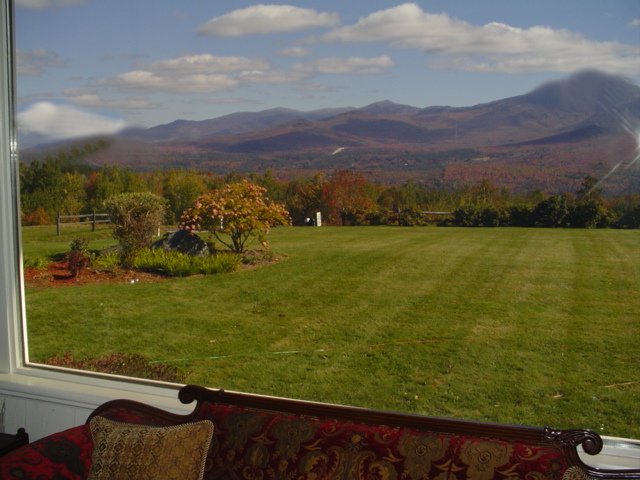
The smaller Lookoff Hotel a half
mile up the
hill from the SHH Resort was built in 1880 and boasted its own golf course
The south end of Sunset Hill Road terminated in the yard of the stable of the
Lookoff Hotel
The Lookoff Hotel is pictured below before it too was taken down

At the north end of Sunset Hill
Road where it begins at Highway 117 was the smallest of the three hotels called
the Homestead Inn.
In the late 1700s this part of a
virgin-forest was partly cleared and in 1802 became the Elm Farm --- so
called because of the elm trees that grew beside the farmhouse for many years.
This edition of the my online photograph album is about the Homestead Inn that
was built in 1889 on The Elm Farm. A smaller farm house commenced to have "boarders"
as guests in
1881 several decades before automobiles climbed up Sunset Hill. Guests of the
three hotels on Sunset Hill Road typically arrived by train to the Lisbon Depot, Littleton Depot,
or a small summer station in Sugar Hill and were brought up to the hotels in horse-drawn carriages.
There was no refrigeration in those days and the three hotels had their own
farms for vegetables, chickens, milk cows, horses, etc.
This picture shows the intersection of
Sunset Hill Road with with Highway 117 before both roads were paved
Note how close the 1889 Homestead Inn was to both Sunset Hill Road and the
connecting highway.
Long lanes were not popular years ago because of the difficulty of clearing deep
snow.
This expanded Homestead Inn was the 14-room home of Simon Bowles and his hard-working
wife Grammy Bowles in 1889

This is the front of the
Homestead Inn when it no longer had a restaurant but still functioned as a Bed
and Breakfast
As I recall it was in 2010 when I snapped the picture below.
The building partly visible on the left is the annex called the "Family Cottage"
The big maple tree in front split from old age rather than any one particular
storm
Fortunately the fallen part of the tree missed the front porch of the Inn.
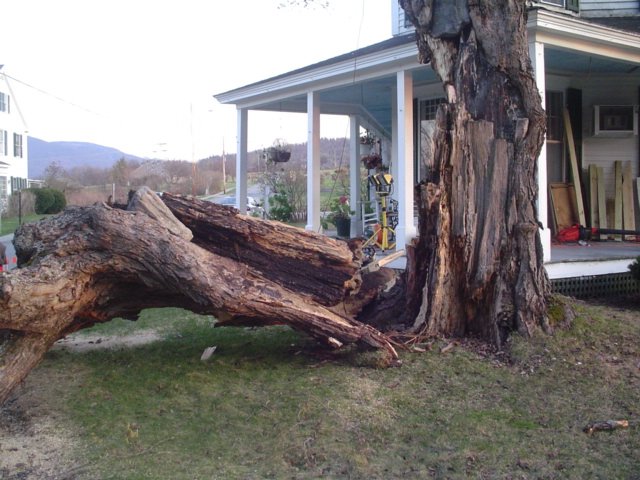
Here's a 2013 winter shot I took of The Sampler
(gift shop and museum) and the Homestead Inn together two years before the Inn
and annex were torn down
Not shown across Sunset Hill Road are the Homestead Inn's annex (called Family
Cottage) and the former Pioneer Club.
The Sugar Hill Sampler (a large historic barn) remains today as a thriving
business that was not torn down along with the Inn and its annex.
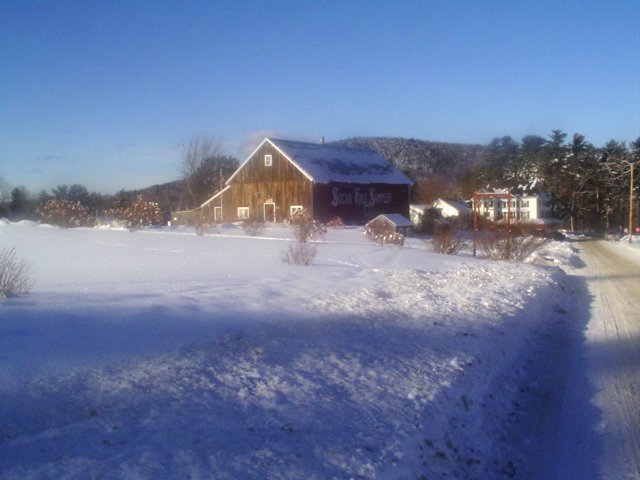
Inside the Sugar Hill Sampler (at
one time the working barn behind the Homestead Inn).
There are so many things for sale, but the specialty is candles and hand made
crafts.
In the back and downstairs are the museum pieces that are not for sale.
The museum's theme is the early history of Sugar Hill and the White Mountains off to the
east.
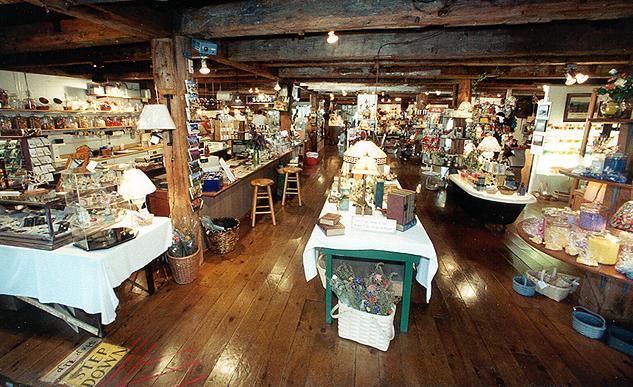
The owner of the Sugar Hill Sampler, Barbara
Serafini, worked many years growing up inside the
Homestead Inn.
She's a wonderful woman who, with her husband Joe Lange, lives in a historic home
called "The Cabin" across the road.
Simon Bowles was her mother's father. Barbara's mother named Essie married an
Italian named called Serry Serafini
Barbara says her father moved to Sugar Hill to raise spaghetti and her.
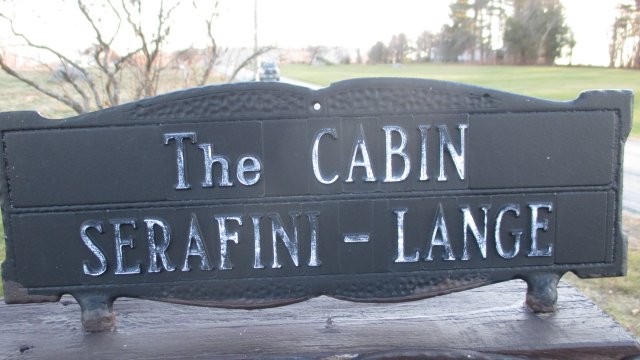
Barbara loaned me many historic photographs of the Homestead. She's a descendant
of family owners of the Homestead Inn.
She's also an organist and the reason the St. Mathews Chapel still has summer
services.
This is a photograph of Barbara
Serafini as a child with her parents sometime around 1940
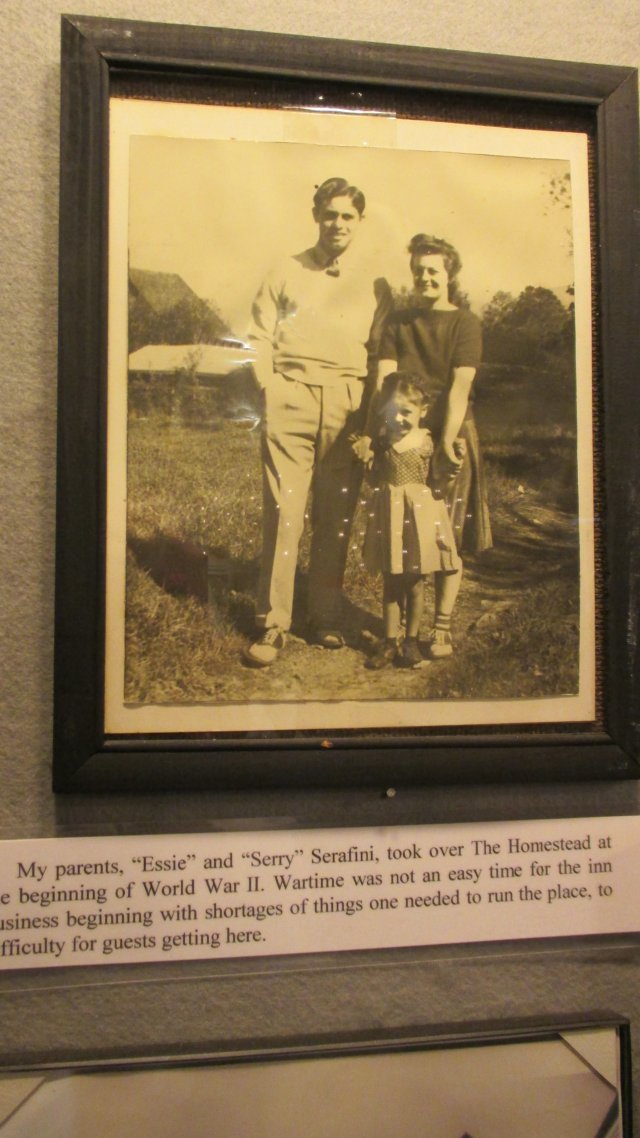
In October 2015 two big
excavating machines
arrived to take down the two buildings of the Homestead Inn.
The Homestead had been closed for several years and about two years ago it was
sold to to a buyer who never got the Inn going again.
A big red barn (now called
The Sugar Hill
Sampler) was a farm barn for Homestead Inn and remains as a very successful gift store and museum.
http://www.sugarhillsampler.com/
It's bright red on three sides and weathered-original on the entrance side
facing south.

This is the Homestead Inn just
before it was demolished in 2015.
The valuable antiques, furniture, and hardwood flooring were no longer in this
empty shell
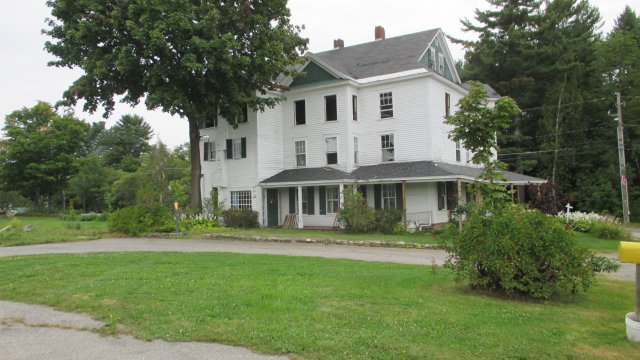
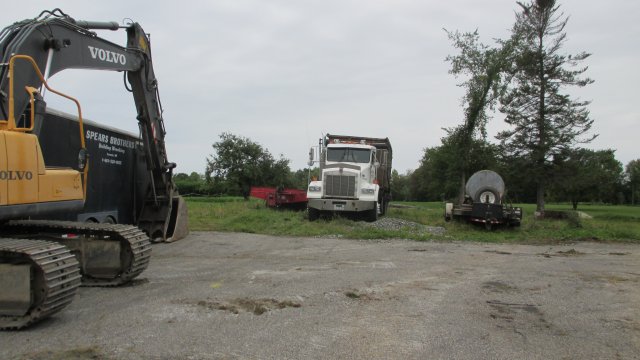

The picture below shows the
Homestead's annex across the road from the Inn and the red barn Sampler
The annex commenced as a milk shed that was expanded into a home for Simon
Bowles' brother Leonard and his wife Elizabeth
The annex was called the "Family Cottage" and was expanded as shown
below for rental rooms of the Homestead.
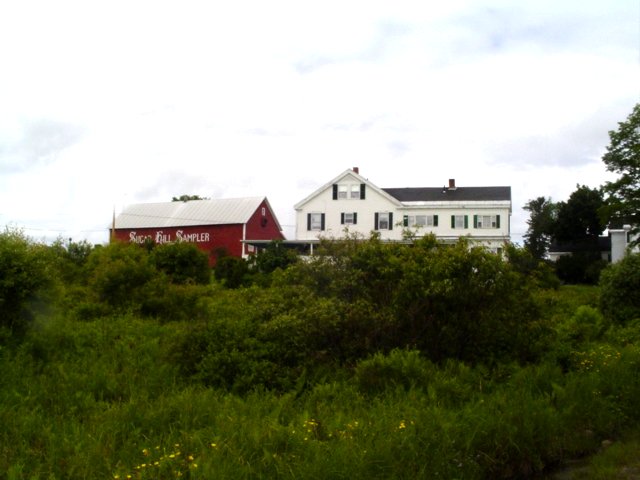
This was the "Family Cottage"
around 1900 when it was the home of Leonard and Lizzie Bowles.
Years later it was expanded into the annex with guest rooms having full private
baths.

The pictures below show the annex
(expanded Family Cottage) in a torn-down jumble in October 2015

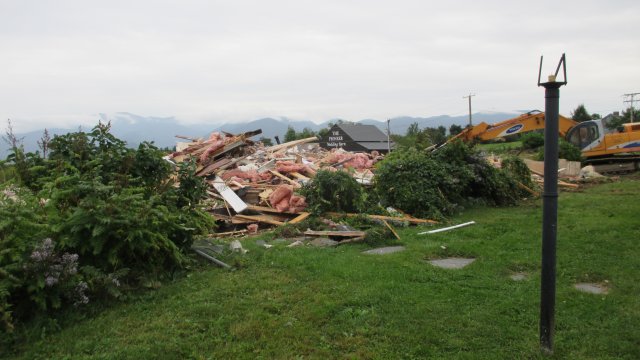
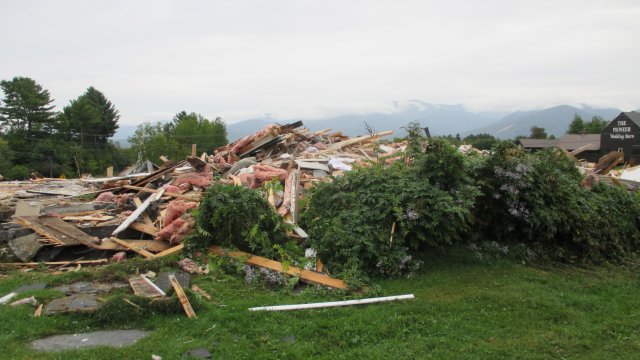
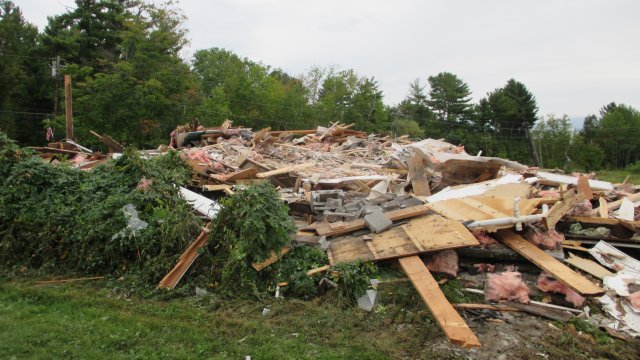
This is the empty site of the
Homestead Inn with my camera facing west toward the Village of Sugar Hill

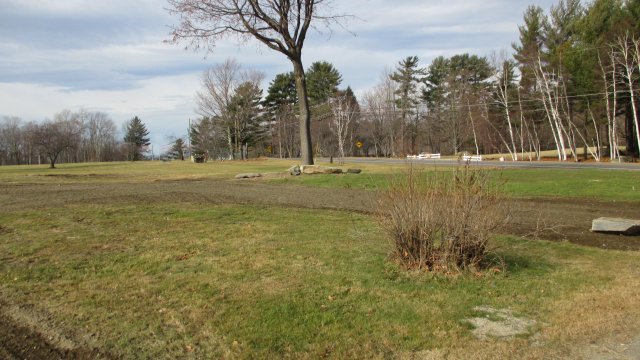
This is the empty site facing east toward what is now The Pioneer Wedding Barn
owned
and operated by Barbara's daughter Holly
http://www.pioneerweddingbarn.com/
The Pioneer Wedding Barn was the former Pioneer nightclub of the Homestead Inn
in the 1940s
The Pioneer Club's history is summarized near the end of this article.

The stone fireplace located on
the lawn west of the Homestead's main building is all that remains to remind us
of the Homestead Inn

The Homestead did not begin as
the 14-room Inn and its annex across the road that were torn down in October
2015.
The Homestead Inn commenced as an 1889 expansion of an 1802 farmhouse of the Elm Farm.
This is an oil painting on the
wall of Barbara's current home (The Cabin)
It shows the Elm Farm's original farmhouse and original (Pioneer) barn separated by
a granary in the early 1800s
Years later the Pioneer barn was moved across Sunset Hill Road and was
eventually remodeled to become The Pioneer Club.
In its place a larger barn was built behind the Homestead Inn. That bigger barn
eventually became the Sugar Hill Sampler.
Especially note the elm trees close to the
original Elm Farm farmhouse, granary, and Pioneer Barn.

What were termed "boarders" were first welcomed into the small farm house in
1881 then owned by Simon and Marcia Bowles.
Many of the "boarders" were workers a half mile up the road at the Sunset Hill
House Resort.
In 1889 the much larger Homestead Inn was commenced as a major expansion to the
Elm Farm farmhouse.
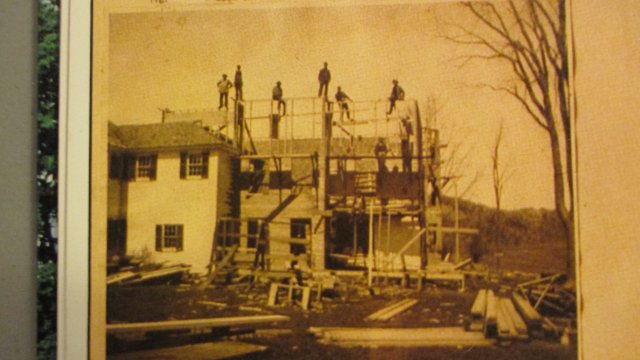
This is the finished 14-room Homestead Inn in 1890
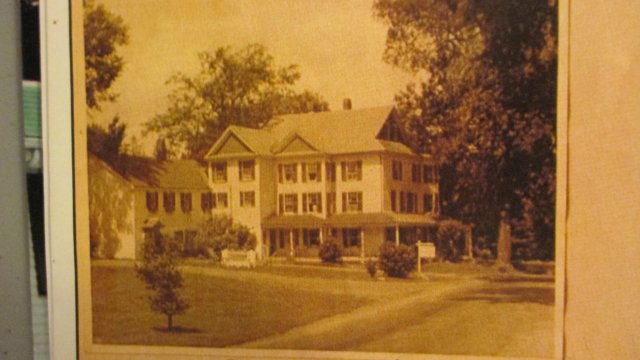
This is a picture taken some years later when the Homestead Inn was a thriving
hotel and restaurant.
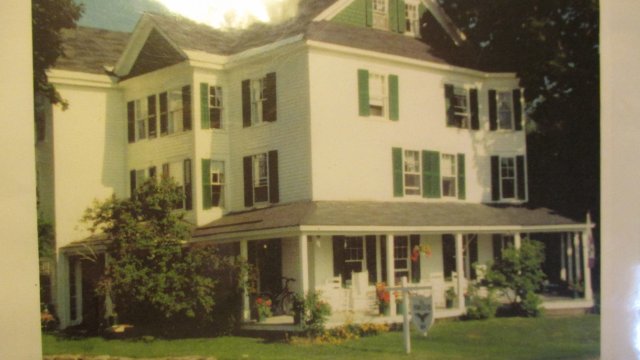

Water came from an Elm Farm
spring before a pipe was put in the ground for water from a mile up to Ore Hill.
Up on Ore Hill the there were several springs under the Spring House across the
road from the Lookoff Hotel.
The Spring House also supplied the SHH Resort and the Homestead Inn with ample water

As late as 1965 the Homestead's
rates were quite reasonable considering they also covered a hearty breakfast and
dinner
The annex was called the "Family Cottage" and had several rooms with full baths



Sugar Hill still does not have
any natural gas lines
Barbara now thinks the "gas street lights" mentioned by her aunt were probably
kerosene lamps

Everything Has a Beginning
Years 1802-1881
The Homestead Herald
Vol. 16, No. 1, Page 1
May 25, 1965

Excerpts from the above article
In the late 1700s William
Adldrich's son, Moses, also from Richmond, NH, came on horseback with only the
barest of supplies, hand tools, and seeds. He set about constructing a rough log
cabin, cleared an acre of land and planted a bushel which gave him a claim to
the land. This was known as a "pitch."
. . .
He toiled hard. It was a
desolate life. He became so lonely for his wife that he ad left in Richmond that
he threw his ax into the woods in utter disgust and quit the dream of a new
existence. He headed toward Richmond to resume the life that he ad so willingly
traded for the wilderness.
When he arrived home his mind
was changed for him. His wife Sarah (known to everyone in later years as
Grammarm, for she was already dearly loved), having planned on his return to get
her, had disposed of the material things that would be useless in the
wilderness. With all preparations made they cam back to the Hill with Moses
riding his horse and Sarah on the "load of goods" hauled by an ox and a cow. The
oxcart held all their worldly possessions which included a black cherry table
mad and marked 1775, a kitchen table with cherry legs, and a solid pine top that
meaureed 34 by 54 inches, Grammar's favoirte chair, a four-poster bed, two
chests, a tiny child's chair, and a clock with wooden works by which three
generations learned to tell time.
. . .
Moses felled the trees
from the virgin forests he had acquired; he hewed the logs with an
adz and went about framing the small one one and a
half story farmhouse in 1802 with timbers, some of which measured 42 feet long,
16 inches wide, and 12 inches thick. They are mortared and pinned and . . .
In Moses' parlor the pine
ceiling boards were cut from logs with an
"up and
down" saw, now seen only among the relics of early
industry in museums.
. . .
In the original farmhouse the
chimney was ten feet square at the foundation and four feet square where it came
out of the roof. It had four flues. There were fireplaces with heavy cranes
supporting iron kettles used for warming water and in the kitchen fireplace
there was a brick oven added . . .

. . .
The little farmhouse was first
painted red with white trim and toward the east there was a bankwall about two
feet high following down to the grade in the lawn. A bank of June roses grew by
the wall. The beautiful elm trees gave the farm its name for 30 years . . .
(In 1880)
Marcia Grove Bowles decided that this family home, The Elm Farm, could "keep
some city boarders for a 'spell' each year to help ease the strain on the
financial demands of the farm. She had married the grandson of Moses and Sarah
and he had received an undivided half of the estate as his share for "seeing the
old folks through." He had inherited as well, an undivided half of their bills.
Farming in these parts with its rocky terrain was always described as "up hill
business.", but Grammy Bowles never winced at hard work. She was as spiritually
strong as the timbers that held up the roof over over her head.
We think this is Grammy Bowles in
the early 1900s

First "Boarders" in
1881 (with Grammy Bowles as the hostess, cook, dishwasher, server, and
chambermaid).
Her husband Simon and his
brother Leonard (the other undivided half), with his wife Elizabeth. lived
across the street in a made-over house that was once a milk shed . . .
Continued in article
First
"Boarders" in 1881at the Elm Farm

A "boarder" around 1883 painted
this picture of the farmhouse and Pioneer Barn.
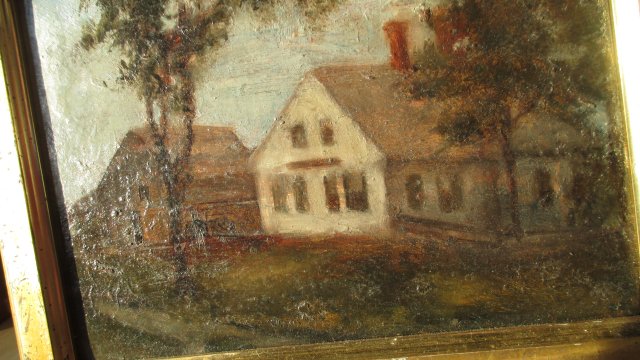
Barbara Serafini wrote the
following about the 1889 expansion of the Elm Farm farmhouse into the Homestead
Inn

Many years later Barbara's
parents winterized the Homestead Inn for guests in the season of snow
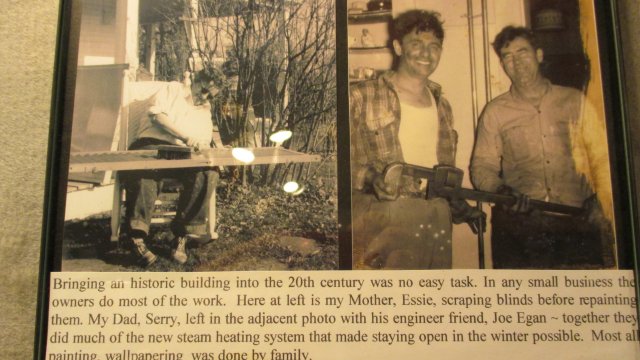
As I mentioned above the Sugar
Hill Sampler owned and operated by Barbara Serafini
remains a thriving business beside what used to be the Homestead Inn
http://www.sugarhillsampler.com/
It's full of good things new and old. The museum has a lot of memorabilia going
back
to when the first permanent settlers (Moses and Sarah Aldrich) arrived in Sugar
Hill and cleared the site of the historic Elm Farm
Don't forget to go down in the basement that's part of the museum to see antique
tools and other memories of a bygone era in Sugar Hill.


There are two Bed & Breakfast hotels that in
2016 remain on Sunset Hill Road --- the Victorian Inn north of our cottage and
the larger Inn on Sunset Hill south of our cottage. The Victorian is a
relatively new restoration of an old Victorian residence. The Inn on Sunset Hill
is a restoration of a building called The Annex amidst the many buildings of the
old Sunset Hill House Resort.
Still Open in 2016 on Sunset Hill
Road
The Victorian (five rental rooms) ---
http://thevictorianonsunsethill.com/
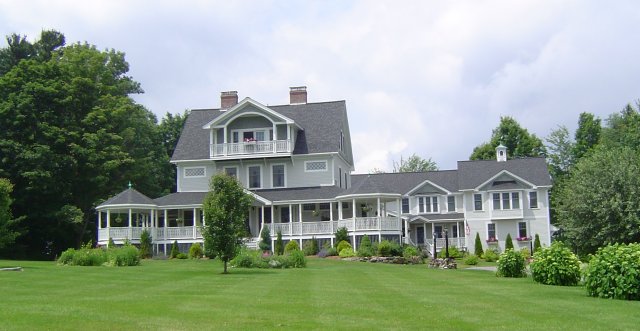
Still Open in 2016 on Sunset Hill
Road
The Inn on Sunset Hill (28 rental rooms), Restaurant, and Golf Course ---
http://www.innatsunsethill.com/
Water for this hotel still is piped down from the springs on Ore Hill.

Question
Why did these grand resorts (like
the Sunset Hill House Resort) of New England and Canada play out in the
latter half of the 20th Century after thriving for 100-200 years in the windy
mountains, cold lakes, and on the Atlantic Ocean's shore?
Jensen Comment
Over 95% of these grand resorts were torn down or burned down in the latter half
of the 20th Century. This begs the question about why these thriving resorts met
their demise. Not far from Sugar Hill in nearby Bethlehem, NH there were 14 such
huge hotels. Today all 14 have either disappeared or are boarded up.
Reasons for the beginning of the end are
numerous and complicated. But one of the main causes was the invention of
effective building air conditioning. Before AC, mothers and children escaped
from the sweltering heat of big cities in the east, south, and even cities in
the Midwest like Chicago and St. Louis. Husbands and fathers frequently visited
on long weekends via a vast network of passenger trains that ended in places
like the Sugar Hill Station.
Other major reasons for the demise of the big
summer resorts of the northeast included improvements in automobiles and roads.
Painstakingly slow Model T Fords were prone to breakdowns and flat tires on
unpaved and rutted mountain roads. Eventually fast cars with amazing tires were
whizzing over paved roads at over a mile-a-minute. New roads were opened up to
real estate in the windy mountains, cold lakes, and on the Atlantic Ocean's
shore. People not only commenced to build second homes for summer retreats and
winter skiing, they built such places as investments in booming real estate
markets following World War II.
Families in urban centers commenced to favor
touring vacations instead of fixed-in-place resorts. What became especially
popular and still is popular is for mom and dad to drop their kids off for a few
weeks in summer camps in New England and then to tour like honeymooners to other
parts of New England and Eastern Canada as well as ocean cruises and and airline
trips to Europe. The comfort and pricing of airline travel especially hurt the
business of creaky old resorts such as when families opted for travel across
Europe instead of annual stays in closer resorts.
Some causes of demise of these resorts were
interactive. With the greatly improved automobiles and roads came the decline in
passenger rail service upon which New England's grand old resorts depended upon
for customers. Although train travel remained the most comfortable and efficient
way to travel from Baltimore to Sugar Hill Station, there was not enough daily
demand year around along the way to keep passenger rail service profitable.
Workers commenced to commute in automobiles to get to and from their jobs in
places like Pittsfield, MA, Hartford, CN, and Manchester, NH. Passenger trains
serving such working towns became unprofitable, especially in the face of union
featherbedding and wage demands. Eventually when it became impossible to travel
to Sugar Hill via a passenger train our creaky old resorts had a lot of empty
rooms with faded wall paper and cracks in the ceilings..
In the meantime, costs increased dramatically
for these labor-intensive grand old resorts. World War II changed the labor
markets dramatically. Women could now leave their chambermaid jobs for careers
in factories and offices. Minimum wage laws were enacted ---
http://en.wikipedia.org/wiki/Minumum_wage
And the oldest hotels like the Homestead Inn
were becoming outdated relative to changed lifestyles. Hotel guests no longer
wanted to go back and forth down the hall to "water closets" shared by other
guests. Television and fast food replaced nightly dining and dancing and
conversations on porches and verandas. Lifestyles became too fast-paced for
rocking chair conversations.
Towering business hotels started being built in
big cities under such names as Hilton, Hyatt, Marriott, and Sheraton. In 1944
near the end of World War II, Stalin, Churchill, and Roosevelt met with the
world's leading economists and bankers in New Hampshire's grand old Mount
Washington Hotel. It was quite a journey by train for these heads of state and
leading economists and world bankers to travel from major airports to Bretton
Woods, NH. In more modern times these busy executives would prefer to meet in
luxury air conditioned hotels much closer to the international airports ---
http://en.wikipedia.org/wiki/Bretton_Woods_Conference
A few if New Hampshire's historic
resorts have survived. These include:
The days of most surviving resorts are probably
numbered. Costs of maintaining these historic structures according to hotel
codes of today are out of sight. Prices of labor and insurance are astronomical.
Families willing to spend $5,000 on a luxury vacation now opt for cruise ships
and tours of Europe, Asia, Australia, and New Zealand.
Pricing in the old days was somewhat
interesting. Costs were often less that $5 per day for room and board instead of
$500 per day ---
Click Here
http://books.google.com/books?id=85Y-AAAAYAAJ&pg=PA6&lpg=PA6&dq=%22Lakes+and+Summer+Resorts+in+New+Hampshire%22&source=bl&ots=vb3zaU51W0&sig=hsohYs-CbUII8g34IhF-NExoA9c&hl=en&ei=Y3eATp_TA4Pe0QGyoMkU&sa=X&oi=book_result&ct=result&resnum=2&ved=0CGYQ6AEwAQ#v=onepage&q&f=false
And today there are no big band dance orchestras playing each and every
evening.
But 1800-1960 was a wonderful era for New
England and Canadian historic luxury resorts and big band night clubs while it
lasted.
Beginning in 1940 there was a men's Pioneer Club
owned and operated by the Homestead Inn that was not a "gentlemen's club" in the same context as
today when such a gentlemen's club usually means strippers and pole dancers. On Sunset Hill
Road after 1940 the Pioneer Club was a nightclub for gentlemanly drinking and
big band music when members could
bring their wives and girl friends for dancing. Barbara tells me her father wore
a tuxedo to greet club members.
The clipping below describes the
The Pioneer Club as it existed in 1965
The walls were covered with historic memorabilia that included china piddle
pots, spinning wheels, bear traps, and antique firearms.

Barbara Serafini wrote the following (I mention Bette Davis in Part 2 of this
Homestead Inn history):
Bette Dvais did indeed go to the Pioneer....I was
too small to see it for myself, but she had a regular table and had a
caricature made for my parents which hung over the table. It is signed & now
in ,my museum as part of the Bette davis exhibit.
The Pioneer was originally a bottle club, but grew
into a very nice private club (necessary to obtain a liquor license in those
days).
Yes, my dad wore a Tux...and men had to wear
jackets...& early on ladies could not wear slacks! No stags allowed!
If a guy took off his jacket to dance my father
went and tapped him on the shoulder...put it back on.
They served dinners....dinner dancing on Saturday.
cocktail lounge open for Homestead guests nightly.
We have a nice scrapbook of that too which I'd like
you to see.
It was not snobby, but it had a fine reputation
that people Still remember and comment about.
Members drove from far and wide to spend evenings
there... Lincoln, Plymouth...Danville, Vt...Berlin, NH...I recall
Somewhere there is a letter to members from my Dad
saying if people could not enjoy a nice evening without being
obnoxious(thats my word) they were not wanted...
There were variations in the evenings for special
guests...music...sometimes a pianist, or vocalist and My father walked
around being sure people were quiet during that event...
there are pictures of me accompanying a violinist
who later became 1st chair of the Denver Symphony
I'll get that scrapbook from Holly so you can see
it...
In the 2015 the defunct Pioneer
Club was restored at considerable expense by Barbara's daughter (Holly) and
became a new business called The Pioneer Wedding Barn.
I wish Holly well in her new new venture
http://www.pioneerweddingbarn.com/
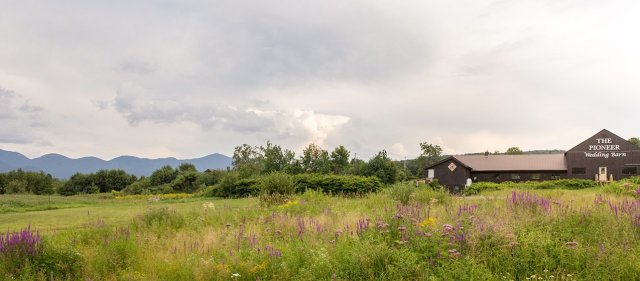
End of Part 1 of the History of the Homestead Inn
Part 2 of this history can be found at
http://faculty.trinity.edu/rjensen/Tidbits/Hotels/Homestead/Set02/Set02.htm
More of Bob Jensen's Pictures and
Stories
http://www.trinity.edu/rjensen/Pictures.htm
History of the White
Mountains and Their Notches/Parks/Trails --- See Mountains
Cottage
Set 01 of my cottage pictures ---
http://faculty.trinity.edu/rjensen/NHcottage/NHcottage.htm
Set 02 inside
the cottage ---
http://www.cs.trinity.edu/rjensen/Tidbits/2009/Tidbits090723.htm
Set 03 inside the cottage ---
www.trinity.edu/rjensen/Tidbits/Cottage\Inside/Set03/Set03InteriorCottage.htm
Set 04
inside the cottage ---
http://www.cs.trinity.edu/rjensen/Tidbits/Cottage\Inside/Set04/Set04InteriorCottage.htm
Photographs of Putting a New Rubber Roof Under Our Widow's Walk
http://cs.trinity.edu/rjensen/Tidbits/CottageHistory/WidowsWalk/WidowsWalk.htm
Indoor
Plants ---
http://www.cs.trinity.edu/rjensen/Tidbits/IndoorPlants/IndoorPlantsFavorites.htm
Amaryllis ---
http://www.cs.trinity.edu/rjensen/Tidbits/2008/Tidbits080212.htm
The Inn on Sunset Hill
(just down from our cottage) ---
https://www.youtube.com/watch?v=A5cqUX0LcbU&t=9s
Cottage History
Sunset Hill House Resort
History Set 01 ---
http://faculty.trinity.edu/rjensen/tidbits/CottageHistory/Hotel/Brochure/Brochure1900.htm
Historic Photographs
(Set 01) of the Sunset Hill House Resort Shared by Gunsmith Ron Resden from
Vermont
http://www.cs.trinity.edu/rjensen/Tidbits/Resden/01ResdenSSH.htm
Historic Photographs
(Set 02) of the Sunset Hill House Resort Shared by Gunsmith Ron Resden from
Vermont
http://www.cs.trinity.edu/rjensen/Tidbits/Resden/02ResdenSSH.htm
Historic Photographs
(Set 03) of the Sunset Hill House Resort Shared by Gunsmith Ron Resden from
Vermont
http://www.cs.trinity.edu/rjensen/Tidbits/Resden/03ResdenSSH.htm
After
the Sunset Hill House Resort was nearly all demolished in 1973, our cottage
(before it was ours)
was moved in 1977 from the golf course across a tennis court and up to where
the former hotel site.
I show pictures of the preparation work prior to the moving the cottage
and its four fireplaces
http://faculty.trinity.edu/rjensen/Tidbits/CottageHistory/OldSite/Set01/Set01.htm
Next
I show pictures of the move to the new site
http://faculty.trinity.edu/rjensen/Tidbits/CottageHistory/NewSite/Set01/Set01.htm
Next
I show the pictures of a 1890 spectacular fire on one of the remaining three
cottages
www.trinity.edu/rjensen/tidbits/CottageHistory/Fire/FireSet01.htm
Iron Ore ---
http://www.cs.trinity.edu/rjensen/Tidbits/2007/Tidbits070924.htm
Sunset Hill House Hotel: The American Dream ---
http://www.cs.trinity.edu/~rjensen/temp/SunsetHillHouse/SunsetHillHouse.htm
Part 1 of the History of the
Homestead Inn Torn Down in 2015
http://faculty.trinity.edu/rjensen/Tidbits/Hotels/Homestead/Set01/Set01.htm
Part 2 of the History of the
Homestead Inn
http://faculty.trinity.edu/rjensen/Tidbits/Hotels/Homestead/Set02/Set02.htm
Bob Jensen's home page
http://www.trinity.edu/rjensen/

















































